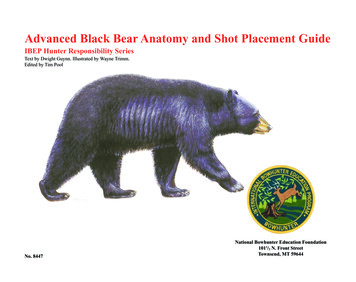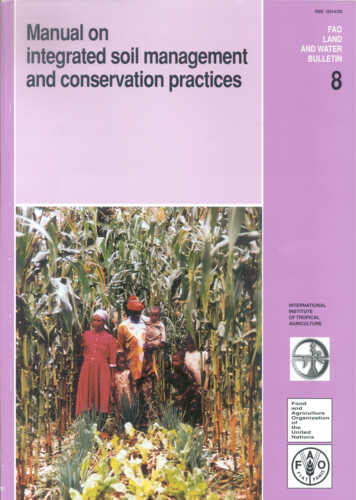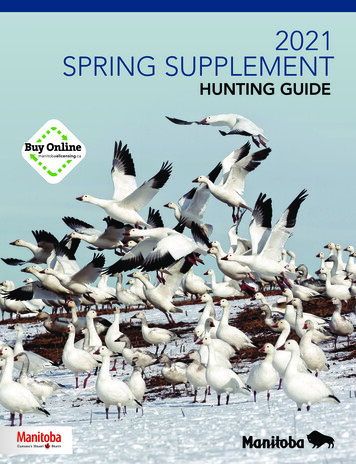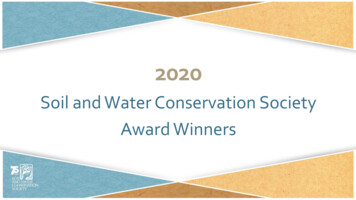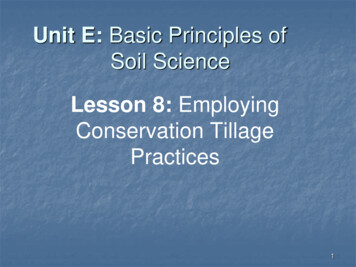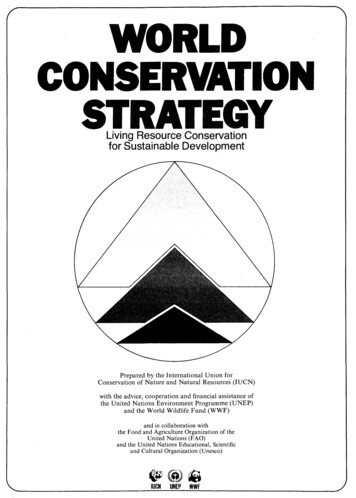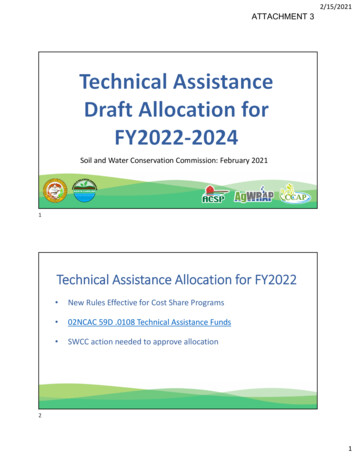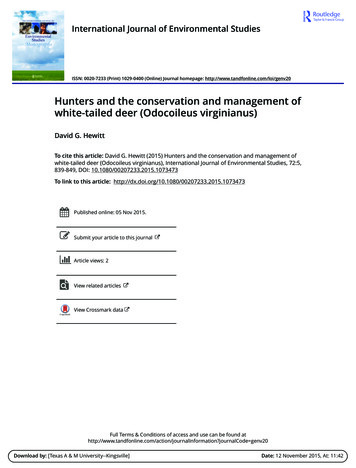
Transcription
International Journal of Environmental StudiesISSN: 0020-7233 (Print) 1029-0400 (Online) Journal homepage: http://www.tandfonline.com/loi/genv20Hunters and the conservation and management ofwhite-tailed deer (Odocoileus virginianus)David G. HewittTo cite this article: David G. Hewitt (2015) Hunters and the conservation and management ofwhite-tailed deer (Odocoileus virginianus), International Journal of Environmental Studies, 72:5,839-849, DOI: 10.1080/00207233.2015.1073473To link to this article: lished online: 05 Nov 2015.Submit your article to this journalArticle views: 2View related articlesView Crossmark dataFull Terms & Conditions of access and use can be found tion?journalCode genv20Download by: [Texas A & M University--Kingsville]Date: 12 November 2015, At: 11:42
International Journal of Environmental Studies, 2015Vol. 72, No. 5, 839–849, ters and the conservation and management ofwhite-tailed deer (Odocoileus virginianus)Downloaded by [Texas A & M University--Kingsville] at 11:42 12 November 2015DAVID G. HEWITT*Caesar Kleberg Wildlife Research Institute, Texas A&M University-Kingsville, 700 UniversityBoulevard, MSC 218, Kingsville, TX 78363, USAWhite-tailed deer are widely distributed in North America and for at least 10,000 years have beenimportant to human beings for food, clothing, and tools. Market hunting and habitat changes in the1800s caused a precipitous decline in the number of white-tailed deer in North America. Huntersacted to restore deer populations. By promoting and helping to enforce hunting regulations, transplanting deer, and funding conservation and management programs, hunters were the primary reason deer populations grew during the 1900s from 500,000 to nearly 30 million. Today white-taileddeer are the most popular big game animal in North America and hunters continue to fund deermanagement and research. Hunters help wildlife agencies to manage white-tailed deer populationswithin ecological and cultural carrying capacity by harvesting deer. Thus, hunters, with their interest in viable deer populations, are integral to the conservation and management of white-tailed deerin North America.Keywords: Hunting; Management; White-tailed deerIntroductionWhite-tailed deer (Odocoileus virginianus) are a medium-sized cervid that evolved inNorth America. The species’ range extends from the Yukon and Northwest Territories inCanada, south through the United States, Mexico, and Central America, into South America as far south as Peru and Bolivia [1]. With such a vast range, white-tailed deer are obviously highly adaptable. They are found in boreal, deciduous, and rain forest as well asprairies, mountains, rangelands, and swamps. White-tailed deer prosper in subarctic, temperate, semiarid, and highly mesic climatic conditions. In recent times, the whitetail’sadaptability has enabled it to thrive in areas heavily influenced by people, such as agricultural and suburban landscapes.Using the criteria of number of hunters and annual harvest, white-tailed deer are NorthAmerica’s premier big game animal. Annually during 2010–2013, about 10 million huntersharvested over 6 million white-tailed deer in the United States [2,3]. An additional 1.2 million hunters pursued big game in Canada during 2012 [4], a significant number of whomhunted white-tailed deer. The whitetail’s distribution partly explains the species’ popularityamong hunters because whitetails are abundant in eastern North America where most ofthe populace lives. White-tailed deer are also popular game animals because they are waryand challenging. The meat is excellent and mature males can grow large, complex antlers*Email: david.hewitt@tamu.edu 2015 Taylor & Francis
840D. G. Hewittthat are desirable trophies. Finally, white-tailed deer are beautiful, elegant animals that areenjoyed by hunters and non-hunters alike. This paper aims to describe the importance ofwhite-tailed deer to various cultures in North America and explain why hunters have beenan essential component of the management system that has resulted in the record populations of white-tailed deer in North America today.Downloaded by [Texas A & M University--Kingsville] at 11:42 12 November 2015Cultural importance of white-tailed deerWhite-tailed deer have been prominent in human cultures in North America for thousandsof years, likely gaining importance after most species of mammalian megafauna wentextinct during the Pleistocene, 12,000–15,000 years ago [5]. Compared to the dozen otherlarge terrestrial herbivores that survived in North America, white-tailed deer have manyattractive characteristics. First, white-tailed deer are widely distributed and much of thespecies’ range includes some of the most productive habitats on the continent, especiallythe Mississippi River valley, prairie and forest biomes of the upper Midwest and centralCanada, and the coastal plains and piedmont regions of the eastern United States. Theseregions, where agriculture was possible, also supported large human populations beforeEuropeans arrived [6]. A second reason white-tailed deer have been especially importantto human cultures is that they have a high biotic potential. Female white-tailed deer canbreed at 6 months of age where high quality forage is available and breeding at 18 monthsof age is common [7]. The average litter size of adult white-tailed deer is 1.5–2 fawns,depending on the nutritional state of the doe, and adult deer typically reproduce every year[7]. The annual rate of increase of white-tailed deer in optimal conditions may be as highas 89% [8], enabling whitetails to sustain a large annual harvest. Finally, white-tailed deerare highly adaptable and therefore can exist and even thrive despite dramatic landscapechanges brought about by prehistoric and modern human cultures [9,10].Native AmericansNative Americans in central and eastern North America hunted deer for food, clothing,and tools. Whitetail remains are common in archeological sites and venison may havecomprised 25% of the diet of Native Americans living in the species’ range [9]. In someinstances, whitetails were such an important resource that deer distribution and abundanceinfluenced tribal boundaries, disputes, and alliances [9]. Native Americans used a dizzyingarray of techniques to hunt deer, including driving deer over cliffs or into traps or waterusing groups of people or fire. Deer were stalked and killed with spears or arrows, caughtin pitfall traps or snares, or pursued until exhausted [9]. Deer not only provided sustenance, but also the hides, bones, sinew, antlers, gastro-intestinal tract, and hooves, whichwere used for clothing, tools, preparing and storing food, and ornamentation.With the arrival of Europeans, deer hides became a commodity that could be traded forEuropean wares. Such trade grew to 85,000 skins annually in the late 1600s and to over500,000 in the middle 1700s [11]. By 1800, Native Americans’ role in trading deer hidesdeclined because deer had been overharvested in areas near the markets and a tide ofEuropean immigrants moving west over the Appalachian Mountains had displaced NativeAmericans into areas where white-tailed deer were less abundant.
Conservation and management of white-tailed deer841Downloaded by [Texas A & M University--Kingsville] at 11:42 12 November 2015European immigrantsWhite-tailed deer were important to European immigrants in much the same way theywere important to Native Americans. Deer provided food, clothing, tools, and commodities, especially hides and venison, for trade. Immigrants and commercial logging and mining operations relied on venison for sustenance. Market hunters shot deer to meet theseneeds and, with the expansion of railroads in the mid and late 1800s, sent increasinglylarge amounts of meat to markets in the upper Midwest and Eastern United States [9].After the Civil War, repeating rifles improved the efficiency of market hunters dramaticallyand when combined with hunting using dogs, night-lighting, traps, pitfalls, and snares,deer populations through most of the species’ range declined to no more than 500,000 by1900 [12].Contemporary North AmericaWhite-tailed deer, from being foremost a resource for exploitation, have become a wildlifespecies for which people have a complex set of positive and negative values. Huntingremains a prominent value, and while only 4.3% of the United States population huntsdeer, support among the general populace for hunting to obtain food is 85% [13]. Evennon-hunters are increasingly interested in consuming locally harvested deer for health andecological reasons [14]. Whitetails have great esthetic value. Many people value the beautyand grace of deer and enjoy viewing, photographing, and painting them. White-tailed deerare the face of nature for many suburban and small town residents who otherwise maytake little notice of local wildlife. White-tailed deer hunting is an autumn ritual that forgesand strengthens ties among family and friends in rural areas across North America [13,15].The ecological value of deer has become widely recognized with the improved understanding of ecosystems and their functioning. Deer are prey for large carnivores, influencevegetation communities through herbivory and seed dispersal, and impact important ecological processes such as nitrogen cycling, fire regimes, and plant succession [16–18]. Theecological value of deer can be positive or negative, depending on the deer density andpeople’s perceptions of deer impacts [19]. Negative values of deer have grown in recentdecades because high-density deer populations conflict with people through agriculturaldamage, deer-vehicle collisions, zoonoses, and damage to landscape plants. Balancing thepositive and negative values of white-tailed deer is a daily challenge for state wildlifemanagement agencies.White-tailed deer hunting has economic value. Big game hunters in the United Statesduring 2011 spent US 16.9 billion on trip related expenses and equipment [2]. Eighty percent of hunters come from metropolitan areas with 50,000 residents (and 42% from citieswith 250,000 residents). Thus, deer hunting results in a transfer of income from cities torural communities; many of which rely heavily on hunting-generated revue. Accountingfor all the economic activity from hunting in the United States, hunters support over500,000 jobs [20]. The net economic value of a species is the total positive minus the totalnegative economic value. Conover [19] calculated the net economic value of deer [whitetailed and mule deer (O. hemionus)] in 2008 US dollars as the positive economic activityfrom hunting ( 12.0 billion) and deer viewing ( 4.6 billion) minus the negative economiceffects from deer-vehicle collisions ( 1.7 billion), losses to agricultural ( 0.6 billion) andtimber ( 1.6 billion) production, and damage to households ( 0.5 billion). Using thesenumbers, the annual net economic value of deer is 12.2 billion. These calculations do not
842D. G. Hewittaccount for the positive and negative ecological values of deer, the existence, empathic, orhistoric value of deer, nor the cost of zoonotic diseases from deer. Nonetheless,white-tailed deer are clearly of high value in North America.Downloaded by [Texas A & M University--Kingsville] at 11:42 12 November 2015Hunters and deer conservation, management, and researchFrom the low deer densities at the end of the nineteenth century, white-tailed deer populations blossomed. Land-use changes, including regenerating forests and abandoned farmfields, provided excellent habitat for deer. The primary reason whitetails were able torecover was a change in people’s relationship with wildlife. As in previous generations,people enjoyed seeing deer, pursuing deer, and eating venison. But, there were fewerplaces to enjoy deer in the early 1900s. In fact, deer in the United States were limited toinaccessible areas in northern Maine, pockets of the Adirondacks, southeastern Massachusetts, the Ozarks, and undeveloped regions of the Gulf Coast and the Mid-AtlanticStates [12]. The low populations of deer made market hunting economically infeasible, butinstead of working to increase deer populations, market hunters simply changed livelihoods. The dearth of deer was noticed by others in North America, but did not concernurban dwellers or farmers. The people most impacted by the scarcity of deer were deerhunters. The fact the deer shortage was important to hunters is evident in their efforts torecover deer populations. Many of these hunters not only had the interest, but also had themeans to influence deer populations using their political connections, professional andgovernmental positions, and private resources. Sport hunters, from the late 1800s to date,are the key component in white-tailed deer conservation, management, and research.Hunters in deer conservationEarly efforts to conserve deer were initiated when deer became scarce around colonialsettlements. The first legislative initiative on low deer densities occurred in 1646 whenRhode Island outlawed harvest of deer between May and November [12]. Like most earlyhunting regulations, this law was enacted, not in answer to a higher conservation ethic, butbecause deer hides and venison were economically important and their loss would limitthe colony’s prosperity. Most colonies followed with their own hunting regulations by themid-1700s, but the laws were generally not enforced. Further, the laws only set huntingseasons; they did not regulate the number of deer that could be harvested [9].The stark decline of deer populations through the 1800s motivated conservation-mindedsportsmen to act. The New York Sportsmen’s Club was organized in 1844 to stop the takeof game animals for the market, the spring shooting of gamebirds, and poor enforcementof game laws [12]. The effectiveness of this group, composed primarily of attorneys, inestablishing and prosecuting local game laws spawned similar sportsmen’s groups in mostmajor eastern cities. Many of these groups hired game wardens to enforce hunting regulations. Hunters not only established and enforced hunting regulations, but deer huntersbought or leased land on which deer populations could be protected or even propagated.Blooming Grove Park in Pennsylvania, the Bisby Club and later Adirondack League Clubin New York, and George Vanderbilt’s Biltmore Estate in North Carolina are prominentexamples of hunters protecting large areas from unregulated hunting and forest destruction[21]. These three preserves were important in restoring deer. They were also among thefirst places in the country where European forestry practices were applied in North
Downloaded by [Texas A & M University--Kingsville] at 11:42 12 November 2015Conservation and management of white-tailed deer843America, to use forests sustainably to the benefit of people and wildlife. This model ofwildlife and habitat protection was followed, albeit on a smaller scale, in many areasacross the eastern United States.Sportsmen used the Press of the early 1870s in their efforts to conserve wildlife.American Sportsman, Forest and Stream, and Field and Stream were periodicals established then. These papers not only related hunting and fishing stories, but described thenatural history of wildlife and published articles defining the character of a sportsman,extolling the virtues of fair chase, and lambasting market hunters for destroying NorthAmerica’s wildlife heritage [21]. These papers supported legislation to limit deer harvest,and to change public attitudes from a strictly utilitarian view of wildlife to a richer set ofvalues celebrating the virtues of sport hunting.In the late 1800s the Boone and Crockett Club (B&CC) promoted wildlife and habitatconservation, especially North American big game. In addition to securing National Parks,National Forests, and National Wildlife Refuges that supported conservation of white-taileddeer, the B&CC acted specifically on behalf of deer. In the 1890s, Club members workedthrough the New York state legislative process to eliminate night- and hound-hunting ofdeer, actions that soon cascaded through other eastern states to limit these controversialhunting methods [12].The patchy distribution of white-tailed deer across the continent during the late 1800sand early 1900s meant there were large areas of suitable habitat devoid of deer. Scatteredreintroductions of white-tailed deer into these areas began in the 1870s and 1880s [22].Early reintroductions in eight states were conducted by private individuals interested inestablishing deer herds that could eventually be hunted. Restocking efforts picked up inthe early 1900s as state game agencies became established. The Pisgah National GamePreserve in western North Carolina, established in 1916 from property of George Vanderbilt, was instrumental in helping reestablish deer in at least eight states from Pennsylvaniato Mississippi [22]. After the Pittman-Robertson Federal Aid in Wildlife Restoration Actin 1937, restocking efforts expanded greatly because hunter-generated funds were nowavailable to support wildlife restoration. Translocations of over 105,000 white-tailed deerhave been documented in the United States since 1878, with about 100,000 occurring after1937 [22]. All these reintroductions were promoted and financially supported by hunters.In the 1940s, the Key deer, a diminutive race of white-tailed deer in the Florida Keys,had declined to fewer than 50 individuals [1]. The B&CC recognized that poaching and apoor understanding of the population’s ecology threatened to extirpate this unique subspecies. In 1950 the B&CC put US 5000 toward hiring a biologist to patrol the islandswhere Key deer were found until more permanent protection could be secured. Although ittook seven more years, authorization for a National Wildlife Refuge was passed by the USCongress and with additional funds from the B&CC and other conservation organizationsto purchase land, the Florida Key deer population was secure [12].Like other remote areas, the rangelands of southern Texas supported viable populationsof white-tailed deer through the era of market hunting exploitation of the late 1800s. Onecritically important area in the early 1900s was a portion of the King Ranch near the GulfCoast about 100 km north of the Mexico border. The King Ranch was founded in 1853and viable deer populations remained because the area was inaccessible and the KingRanch family had a strong conservation ethic. Members of the King Ranch family weremotivated not only by wildlife conservation, but by a love of the outdoors and hunting.R.J. Kleberg, Sr. and Caesar Kleberg, family members with a passion for wildlife conservation, established hunting rules for the King Ranch before state harvest regulations
Downloaded by [Texas A & M University--Kingsville] at 11:42 12 November 2015844D. G. Hewittexisted and which were more restrictive than the state regulations that were eventuallypassed. The rules were designed to prevent overharvest, especially during the frequentdroughts that stressed all wildlife in Texas [23]. For example, the annual bag limit on theKing Ranch was one male deer with at least eight antler points and the hunting seasonclosed on 15 December when the breeding season began. Furthermore, no hunting wasallowed around water sources or other places where deer naturally concentrated and hunting was stopped altogether during drought when deer were especially stressed [23]. Thesevoluntary efforts not only served the interest of the hunters on King Ranch, but benefittedconservation of white-tailed deer through much of the country. From the 1920s throughthe 1980s King Ranch provided deer for relocation efforts across Texas and in severalstates in the southeastern United States, with over 12,000 white-tailed deer trapped andrelocated in the 1960s and 1970s alone [23,24].Hunters in deer managementHunters were essential in white-tailed deer conservation in the early 1900s. They remainedessential to deer management as restoration efforts bore fruit and white-tailed deer numberssurged past 15 million in the 1970s on their way to 30 million today [10]. Hunters’ contributions were largely funding. Later, hunters assisted state wildlife agencies in controllingdeer populations. Hunters have taken on a large share of management efforts during thepast 25 years.Wildlife management is expensive and as state wildlife agencies were established in theearly 1900s, money was needed to survey deer populations, establish and enforce annualharvest regulations, monitor the size and composition of the annual harvest, and otherwisemanage the growing deer population. Funding came largely from hunters. The Pittman–Robertson Federal Aid in Wildlife Restoration Act of 1937 was achieved with the supportof sportsmen. This Act levied a 10% tax on ammunition and firearms. Thus, hunters andshooters carry much of the burden of wildlife management in the United States. The Acthas since been amended to include archery equipment. It provided US 336 million forwildlife management in 2009 [25]. These funds are used to support restoration and management of many wildlife species, but deer hunters, as the largest proportion of the huntingpublic, generate a large portion of these funds. Additional revenue was pumped directlyinto state wildlife agencies through hunting license fees.Hunters not only funded the deer management programs of state agencies, however;they also became the primary mechanism by which agencies manipulated deer numbers.Agencies could increase, stabilize, or reduce deer populations by altering the number andsex of deer that could be harvested, season dates, method of take, and many other factors[26]. During the early- to mid-1900s when whitetail populations were depleted and farbelow population objectives, state agencies used regulations and educational campaigns toencourage hunters to shoot only male deer. This approach worked well when the objectivewas to increase deer populations and soon became established as a standard of good hunting practice. In areas of good habitat where the high reproductive capacity of white-taileddeer could be fully expressed, deer populations increased rapidly. Deer became overabundant in portions of Pennsylvania as early as the 1930s and deer managers had considerabledifficulty in encouraging hunters to harvest female deer also. This cultural reluctance byhunters to harvest females posed a challenge for the next 50 years of deer management[27]. Hunters had been taught to shoot only male deer and once harvest of females becamenecessary, hunters were reluctant to participate [10].
Downloaded by [Texas A & M University--Kingsville] at 11:42 12 November 2015Conservation and management of white-tailed deer845By the 1970s deer populations in many areas were overabundant, were numericallyheavily dominated by females and because of the heavy harvest of male deer, had few ifany mature males. Regulations, such as the earn-a-buck approach in which hunters had toharvest a female deer before they could hunt a male, and special seasons directed to harvesting female deer exclusively, did help to increase the harvest of female deer. In addition, educational efforts by state agencies and by private NGOs such as the Quality DeerManagement Association explained that harvesting female deer was actually in the hunter’sself-interest and was essential if deer populations were to avoid depletion of their primaryforage species and cause wider ecological damage through habitat impacts. The KinzuaQuality Deer Cooperative in Pennsylvania provides an example of hunters working with awide variety of stakeholder groups to control white-tailed deer populations to reduce problems caused by the deer, although not all hunters are satisfied with the lower deer densities[27]. These approaches eventually worked and in 1999, the number of antlerless deer harvested in the United States surpassed the harvest of antlered deer [10]. In 2013, moreantlerless deer are still harvested than antlered deer, but the antlerless harvest has declinedin the past 3 years in part because deer populations in many areas are nearing populationobjectives [3].These population management efforts also helped reduce socio-economic problemscaused by overabundant deer numbers. Deer damage is acute in suburban areas wheredeer-vehicle collisions are common and deer eat landscape vegetation and gardens. Thethreat of zoonosis also increases in suburban areas with high deer densities. Special deerhunts were used successfully in areas of Connecticut to reduce the incidence of deervehicle collisions, a significant concern because such collisions are frequent, highlyexpensive in direct damage to vehicles and insurance claims, and can result in humaninjury or death [20]. Archery and firearm hunts in four suburban areas of New Jersey andPennsylvania over 3–10 years reduced deer densities from 30–80 to 17–18 deer/km2 [28].The expense of removing deer using traditional deer hunting is borne by the hunters.Organized recreational hunts in suburban areas cost US 14–177/deer, depending on organizational and law enforcement costs whereas removing deer by trapping (greater than US 1000/deer) or using sharp-shooters (US 90–260/deer) is expensive and finding places torelease trapped deer is increasingly difficult [29].It is not only through their ability and willingness to harvest animals that hunters assistin management of deer populations. Beginning with their early efforts to protect and reintroduce deer when populations were at their lowest, hunters have now invested vastresources to otherwise help manage deer throughout their range [10]. Hunters assist in deercensus efforts using cameras, spotlights, and helicopters. They provide forage for deer byimproving habitat, planting food plots, or providing various supplements. Additionally,hunters increasingly make harvest decisions by choosing the age of male deer to harvestand when and where female deer should be harvested [30]. State agencies have respondedto this increased sophistication and capacity of deer hunters to help meet managementgoals and carry out important management practices. In several states, wildlife management agencies are provided with reliable deer census and harvest data from propertiesdirectly managed by hunters who either lease or own the land outright. In many cases, thestate agencies work closely with the hunters involved and often permit considerable flexibility in deer harvest protocols. Such cooperative efforts produce far more refinedapproaches to deer conservation and management than would be otherwise possible. Stateand provincial wildlife agencies are everywhere challenged by the many demands for theirservices and can only allocate human and financial resources within their means.
Downloaded by [Texas A & M University--Kingsville] at 11:42 12 November 2015846D. G. HewittThe vast privately owned lands in southern Texas are a remarkable example of huntersproviding a level of management that would be financially impossible for a state wildlifemanagement agency. The King Ranch is an example. In addition to contributing to therestoration of white-tailed deer across a large portion of the species’ range, the ranchbegan its wildlife management programme when Val Lehmann was hired in 1945, one ofthe first wildlife biologists to work for a private ranch anywhere in North America [23]. Aseries of biologists have been hired by the King Ranch ever since. These biologists experimented with helicopter surveys to count deer in the early 1960s and by the late 1990s hadestablished 5646 km of helicopter transects that were flown annually to estimate deer numbers on the ranch’s 333,865 ha [24]. As Caesar Kleberg himself had established longbefore, these biologists continued to implement harvest regulations appropriate to theranch’s deer management goals, based upon habitat availability and an understanding ofdeer-forage interactions. Ranch biologists now have extensive databases of past harvestand survey records for making total harvest recommendations. Additional harvest criteriafor male deer based on age and antler size are also applied and are designed to ensure deerlive long enough to express their full antler potential by growing to maturity. Many pastures on the King Ranch are leased for deer hunting and each lessee is required to have aprofessional biologist on staff to ensure that the location, age, weight, and antler size of allharvested deer is recorded. These harvest records are compiled annually and serve as aresource for the King Ranch to use in refining future harvest guidelines.The King Ranch has been a leader in managing white-tailed deer on private land insouthern Texas, but it is by no means alone. In 2011, deer hunters in Texas flew helicoptersurveys on 4 million ha costing about US 3 million [31]. Following guidelines establishedby the state wildlife agency, hunters captured over 12,000 deer using helicopters in supportof privately funded management projects [31]. Untold hours were invested in camera andspot-light surveys, but such activities are more difficult to track because they do notrequire authorization by the state. Clearly hunters are a significant force in white-taileddeer management.Hunters in deer researchHunters are not only motivated to conserve and manage deer, but they relish knowledgeabout deer and are generous with their time, money, land, and other resources in supporting research on white-tailed deer. Funds for deer research come from the Pittman–Robertson Federal Aid in Wildlife Restoration Act. Other funds are given directly to deerresearch. The importance of deer hunting in Texas is illustrated by the US 5 million thathunters have given to the Caesar Kleberg Wildlife Research Institute (CKWRI) inKingsvi
500,000 in the middle 1700s [11]. By 1800, Native Americans’ role in trading deer hides declined because deer had been overharvested in areas near the markets and a tide of European immigrants moving west over the Appalachian Mountains had displaced Native Americans into areas whe
